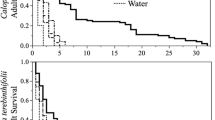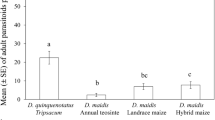Abstract
The palaeotropical, gregarious, endoparasitic braconids Cotesia sesamiae, Cotesia flavipes and Cotesia chilonis were recently imported into Benin as candidates for biological control of stem and cob borers of maize. Host acceptability and host suitability of six gramineous borers occurring in western Africa, namely the noctuids Sesamia calamistis, Sesamia poephaga, Busseola fusca and the pyralids Coniesta ignefusalis, Eldana saccharina and Mussidia nigrivenella, to these candidate parasitoids was evaluated in order to gain insight into the physiological suitability of the natural and factitious hosts. All hosts were accepted by all Cotesia spp., except M. nigrivenella which was not attacked by Co. chilonis. Parasitoid progeny development was successful in S. calamistis, S. poephaga and Con. ignefusalis. Sesamia calamistis was the most suitable host for Cotesia spp. development, in terms of duration of developmental time, brood size and mortality of parasitoid progeny.
Résumé
Les braconides palaeotropique endoparasitoides grégraires Cotesia sesamiae, Cotesia flavipes et Cotesia chilonis ont été récemment introduits au Bénin comme agents de lutte biologique des foreurs de tiges et mineurs d’épis. Les informations sur la convenance et l’acceptabilité de l’hôte de six foreurs de céréales présents en Afrique de l’Ouest, precisement les Noctuidae Sesamia calamistis, Sesamia poephaga, Busseola fusca, et les Pyralidae Coniesta ignefusalis, Eldana saccharina et Mussidia nigrivenella Ragonot, ont eté recueillies pour permettre de comprendre l’ancienne et la nouvelle associations parasitoide / hôte. A l’exception de M. nigrivenella qui n’était pas attaqué par Cot. chilonis, tous les autres foreurs étaient accepté par Cotesia spp. Les parasitoides ont pu se développer seulement sur S. calamistis, S. poephaga et Con. ignefusalis. Sesamia calamistis était de loin l’hôte le plus convenable pour le développement de Cotesia spp. s’agissant de la durée de développement, la taille de la progéniture et la mortalité préimaginale des parasitoides.
Similar content being viewed by others
References
Appert J. (1952) Les parasites animaux des plantes cultivées au Sénégal et au Soudan. Paris, Jouve, 272 pp.
Bosque-Pérez N. A. and Dabrowski Z. T. (1989) Mass rearing of the maize stemborers Sesamia calamistis and Eldana saccharina at IITA, pp. 22–26. In Towards Insect Resistant Maize for the Third World. Proc. of the International Symposium on Methodologies for Developing Host Plant Resistance to Maize Insects, Mexico, D.F. CIMMYT.
Bosque-Pérez N. A., Ubeku J. A. and Polaszek A. (1995) Survey of parasites of Sesamia calamistis (Lepidoptera: Noctuidae) and Eldana saccharina (Lepidoptera: Pyralidae) in southwestern Nigeria. Entomophaga 39, 367–376.
Brénière J. and Bordat D. (1982) Interest and difficulties of biological control by introduction of natural enemies, case of the rice borers in Africa. Agronomie Tropicale 37, 203–206.
Gahukar R. T. (1981) Biological control of insect pests of sorghum and pearl millet in West Africa, pp. 69–91. In Proceedings of the International Conference on Biological Control of Pests: Its Potential in West Africa. US Agency for International Development, Dakar, Senegal.
Gifford J. R., and Mann G. M. (1967) Biology, rearing and a trial release of Apanteles flavipes in Florida Everglades to control the sugarcane borers. J. Econ. Entomol. 60, 44–47.
Gounou S., Schulthess F., Shanower T., Hammond W. N. O., Braima H., Cudjoe A. R., Adjakloe R., Antwi K. K. and Olaleye I. (1994) Plant Health Management Research Monograph No. 4. International Institute of Tropical Agriculture, 31 pp.
Harris K. M. (1962) Lepidopterous stemborers of cereals in Nigeria. Bull. Entomol. Res. 53, 139–171.
Hokkanen H. M. T and Pimentel D. (1984) New approach for selecting biological control agents. Can. Entomol. 116, 1109–1121.
Hokkanen H. M. T. and Pimentel D. (1989) New associations in biological control: Theory and practice. Can. Entomol. 121, 829–840.
Inayatullah C. (1983) Host selection by Apanteles flavipes (Cameron) (Hymenoptera: Braconidae): Influence of host and host plant. J. Econ. Entomol. 76, 1086–1087.
Ingram W. R. (1958) The lepidopterous stalk borers associated with gramineae in Uganda. Bull. Entomol. Res. 49, 67–83.
Kajita H. and Drake F. (1969) Biology of Apanteles chilonis and Apanteles flavipes (Hym: Braconidae) parasites of Chilo suppressalis. Mushi 42, 163–179.
Kfir R. and Bell R. A. (1993) Inter-seasonal changes in the populations of the African maize stemborer, Busseola fusca Fuller (Lepidoptera: Noctuidae) and its parasitoids in Natal, South Africa. J. Afr. Zool. 107, 543–553.
Mally C. W. (1920) The maize stalk borer Busseola fusca Fuller. Bull, Dept. Agric., Union of South Africa 3, 111 pp.
Mohyuddin A. I. (1971) Comparative biology and ecology of Apanteles flavipes Cameron and Apanteles sesamiae Cameron as parasites of gramineous borers. Bull. Entomol. Res. 61, 33–39.
Mohyuddin A. I. (1991) Utilization of natural enemies for the control of insect pests of sugar-cane. Insect Sci. Applic. 12, 19–26.
Nagaraja H. (1971) Morphological differences between Apanteles chilonis (Munakata) and Apanteles sesamiae Cameron (Hymenoptera: Braconidae) parasites on gramineous moth borers, pp. 59–61. Tech. Bull. No. 14. CIBC.
Ngi-Song A. J., Overholt W. A. and Ayertey J. N. (1995) Suitability of African gramineous stemborers for development of Cotesia flavipes and Cotesia sesamiae (Hymenoptera: Braconidae). Environ. Entomol. 24, 978–984.
Oketch S. H. O. and Overholt W. A. (1996) Comparative biology of Cotesia chilonis (Hymenoptera: Braconidae) on selected African gramineous stemborers. Biocontr. Sci. Technol. 6, 595–602.
Overholt W. A., Ngi-Song A. J., Kimani S. K., Mbapila J., Lammers P. and Kioko E. (1994) Ecological considerations of the introduction of Cotesia flavipes Cameron (Hymenoptera: Braconidae) for biological control of Chilo partellus (Swinhoe) (Lepidoptera: Pyralidae), in Africa. Biocontr. News Info. 15, 19–24.
Polaszek A. and Walker A. K. (1991) The Cotesia flavipes species-complex: Parasitoids of cereal stemborers in the tropics. Redia 74, 335–341.
SAS Institute (1985) User’s Guide: Statistics. SAS Institute, Cary. NC.
Smith J. W., Wiedenmann R. N. and Overholt W. A. (1993) Parasites of Lepidopteran Stemborers of Tropical Gramineous Plants. ICIPE Science Press, Nairobi. 89 pp.
Tarns W. H. T. and Bowden J. (1953) A revision of the African species of Sesamia Guenée and related genera (Lepidoptera: Agrotidae). Bull. Entomol. Res. 43, 645–678.
Ullyett G. C. (1935) Notes on Apanteles sesamiae Cameron, a parasite of the maize stalk borer (Busseola fusca Fuller) in South Africa. Bull. Entomol. Res. 26, 253–262.
van Rensburg J. B., Giliomee J. H. and Walters M. C. (1988) Aspects of the injuriousness of the maize stalk borer, Busseola fusca larvae on the growth and yield of maize. Bull. Entomol. Res. 78, 101–110.
Walker A. K. (1994) Microgastrine (Hymenoptera: Braconidae) parasitizing cereal stemborers in Africa. Bull. Entomol. Res. 84, 421–434.
Wiedenmann R. N. and Smith J. W., Jr. (1995) Parasitization of Diatraea saccharalis (Lepidoptera: Pyralidae) by Cotesia chilonis and C. flavipes (Hymenoptera: Braconidae). Environ. Entomol. 24, 950–961.
Yasumatsu K. (1967) Distribution and bionomics of natural enemies of rice stemborers. Mushi 39, 33–44.
Author information
Authors and Affiliations
Rights and permissions
About this article
Cite this article
Hailemichael, Y., Schulthess, F., Smith, J.W. et al. Suitability of West African Gramineous Stemborers for the Development of Cotesia Species. Int J Trop Insect Sci 17, 89–95 (1997). https://doi.org/10.1017/S1742758400022207
Accepted:
Published:
Issue Date:
DOI: https://doi.org/10.1017/S1742758400022207
Key Words
- Cotesia spp. stemborer
- host acceptability
- host suitability
- biological control
- new associations
- maize
- West Africa




